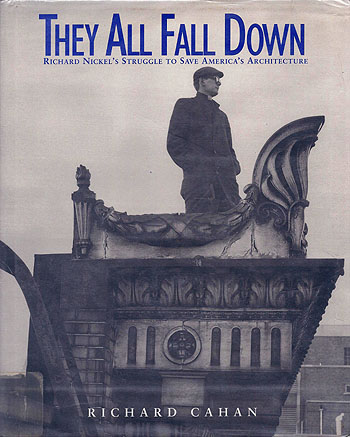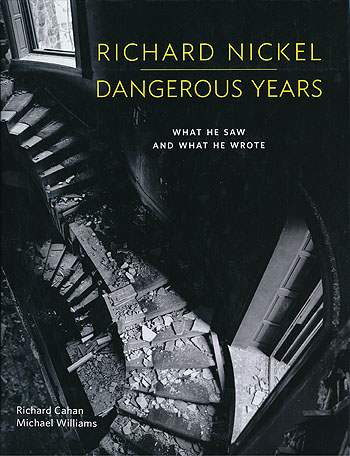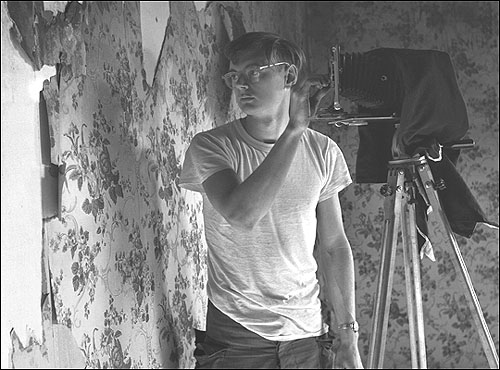
NOW AVAILABLE
CLICK TO ORDER
Richard Nickel (May 31, 1928 - April 13, 1872) Date: 1994 Title: They All Fall Down. Richard Nickel’s Struggle to Save America’s Architecture (Hard Cover - DJ) (Published by The Preservation Press, National Trust for Historic Preservation, Washington D.C.)
Author: Cahan, Richard
Description: "Nickel also drove to Taliesin in Wisconsin to interview Frank Lloyd Wright. Sleepy at first, the 85-year-old Wright later gruffly monopolized the conversation offering little help and putting Nickel off... A year later... Wright must have been impressed by Nickel. He told Richard that his photos of the Bartlesville, Oklahoma, skyscraper were the best he had ever seen and seemed surprised that Nickel had discovered Adler and Sullivan’s Loeb Apartments ..." page 76. Nickel’s passion was Sullivan, but he also left an invaluable record of the buildings of Frank Lloyd Wright. Original list price $24.95. (First Edition)
Size: 8.25 x 10.25
Pages: Pp 261
ST#: 1994.67.0512
Date: 2016
Title: Richard Nickel, Dangerous Years. What He Saw And What He Wrote (Hard Cover DJ) (Published by CityFiles Press, Chicago)
Author: Cahan, Richard; Williams, Michael
Description: Dust jacket: "This breathtaking book is the closest you will ever come to knowing Richard Nickel. Collected here are his own writings, many yellowed with age. Long letters and quick notes. Research and everyday communication. Letters of discovery and of despair. Typed, handwritten, and carbon copied. Some were never sent. We are finally catching up to Richard Nickel. He took risks, spoke his mind, and championed an oversize cause. His rebellion against the shortsighted disregard of an American genius, the architect Louis Sullivan, appeals to a new generation interested in conservation—whether of old buildings or natural resources. What he left behind—his letters and his photographs—still inspires people to stop and look. He is more relevant today than ever before." Includes photographs of : Price Tower (1955 - S.355); Sullivan Bungalow (1900 - S.005); Falkenau Row Houses (Sullivan 1888); Sullivan (1892 - S.019). More than 250 photographs and illustrations. Original list price $60.00. (First Edition)
Size: 9.75 x 12.75
Pages: Pp 264
ST#: 2016.47.0420Robie House, 1955-60 Henderson Residence, 1960-67 Lake Geneva Hotel, 1967 Everyday Art, Winter 1968 Rookery Building, 1972 Frank Lloyd Wright Newsletter, V2 #2 - 1979 Nickel's Chicago, A Lost City's Lost Champion
In 'Nickel's Chicago,' a Lost City's Lost Champion
by Edward Lifson
http://www.npr.org/templates/story/story.php?storyId=9601376April 16, 2007 - Historic preservationists can be passionate about keeping the wrecking ball from beloved buildings. But how many would lay down their lives?
One man did: Architecture photographer Richard Nickel spent years with his camera, documenting - and arguing against - the demolition of buildings in Chicago. Thirty-five years ago this month, Nickel died trying to document the demise of a building designed by Louis Sullivan, whose architecture helped define the Chicago cityscape.
In the '60s and early '70s, Nickel watched the demolition of so many of Sullivan's buildings - and buildings created by other turn-of-the-century masters - that he wrote, "I look forward to the day when I never have to enter a wet, charred, smoky building again."
A few of Sullivan's Chicago buildings still stand, including a State Street department store with windows framed by swirling metal ornaments; the celestial Auditorium Theater still presents music and dance. But after World War II, such buildings fell like leaves in autumn to make space for a new way of life. That's when Nickel started trying to preserve on film what he felt society was losing. A new book of his black-and-white photographs “Richard Nickel's Chicago: Photographs of a Lost City” was co-edited by Michael Williams and Richard Cahan, who say the chronology of the book tells a story.
"It's like watching a train," Cahan says. "As a long train goes by, and you see the cars - you stop looking, and then when the caboose comes by, all of a sudden you take a close look because that's the last moment you'll see the train. Part of the beauty of his pictures is that these buildings are about to go under; you'll never see them again."
Joel Meyerowitz, who's photographed lost buildings, people, and culture at Ground Zero in New York, picked up a copy of the Nickel book on a trip to Chicago.
"His pictures are eloquent beyond words," Meyerowitz says. "They show us the greed, the corporate greed that infects our cities and has made them less livable - how they blot out the light and reshape our urban experience. And he didn't use any tricks, this guy - he let his heart guide him."
By day, Nickel picketed in front of buildings slated for demolition; he wrote angry letters at night. And he'd sneak into the half-destroyed buildings when the wreckers had gone home. Architect and preservationist John Vinci would often join him to photograph and salvage Sullivan's uniquely organic ornamentation.
"We just never thought about it as dangerous in that sense," Vinci says. "We had other close calls, but nothing like what happened."
On a gray April morning in 1972, Nickel went by himself into Louis Sullivan's Stock Exchange building. He didn't return home that night. Vinci and other friends spent a couple of days looking for Nickel in the Stock Exchange rubble.
"It was raining and damp, and we were walking around saying, 'Richard, Richard.' No Richard. Then we found his camera, and his hat, I think, and his suitcase."
Part of the building had collapsed on Nickel. It took four weeks to find his body.
Nickel's catalog of Sullivan buildings was doomed never to be completed. But Vinci saved his friend's negatives - more than 11,000 of them - and started the Richard Nickel Committee and Archive. It displays fragments of Sullivan buildings along with Nickel's original prints. The archive is located in the basement of an old Victorian graystone on a nice North Side street - a thoroughfare on which they're tearing down old buildings to put up new condos.
Richard Nickel self-portrait, 1950s. Richard Nickel Committee
Additional Articles
The Richard Nickel Story
http://www.wttw.com/main.taf?p=1,7,1,1,32Richard Nickel
http://en.wikipedia.org/wiki/Richard_Nickel


